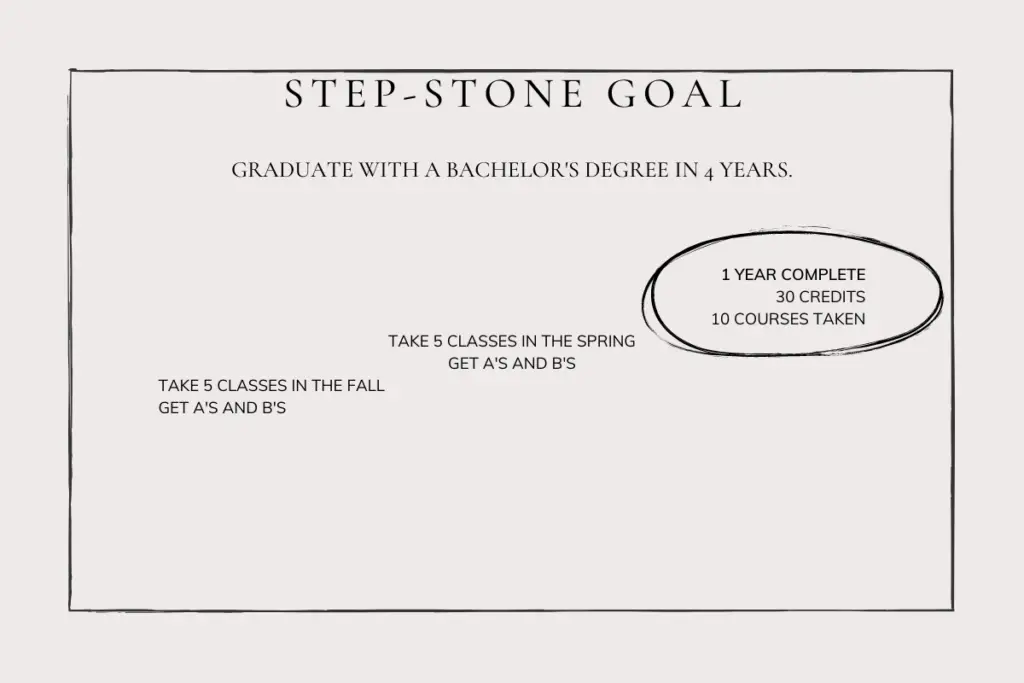I’ve been thinking about how to set goals and the importance of effective goal-setting techniques. The quality of the goal we set matters; so does the strategy and intention we use to accomplish it.
How do we know we’ve set a good goal and how do we know if our strategy is good enough?
Here’s what I found!
What Is A Goal?
Google defines a goal as “the object of a person’s ambition or effort; an aim or desired result.” Dictionary.com says it’s “the result or achievement toward which an effort is directed; an aim; an end.”
Basically, a goal is a targeted objective you have that requires intention, planning, and ambition. A goal is a desired outcome.
Types of Goals:
There are many different types of goals. There are time-based goals like short-term and long-term goals. There are performance-based goals involving the achievement of a specific outcome. And then, there are process-oriented goals that focus more on a commitment to certain processes that will help achieve an outcome.
Here are some examples of these types of goals as they relate to college.
time-based goal:
Long Term: Graduate with a Bachelor’s in 4 years.
Short Term: Take 5 classes this semester.
performance-based goal:
Get straight A’s.
Process-oriented goal:
Attend all my classes, turn in all assignments, and study every week.
You can set goals in any area of your life.
People often set goals for their:
- career
- relationships
- business
- health
- finances
- education
- self-development
- faith
What Is Goal Setting?
Goal-setting is the process that takes place after you’ve selected a goal. Once you’ve chosen a goal you want to accomplish, you decide how you’re going to accomplish it. Goal-setting is basically taking the time to plan out the steps you’ll take to reach your desired outcome.
Why Is Setting A Goal Important?
Goal-setting is important because it helps us acknowledge that we each have an active role to play in our own lives. In any domain, in any sphere of activity or knowledge or influence, we have an obligation to ourselves to show up. Every area of our lives that we care about deserves intention.
There are also several benefits to goal setting.
GOAL-SETTING HELPS US:
- Determine What We Want
It’s not uncommon that people are sometimes unfamiliar with what they really want in life. They struggle thinking about what they want now, what they want most, what they are willing to prioritize, and what they are willing to sacrifice. At its most basic level, goal-setting ensures that there is in fact a goal or an intention.
- Create A New Normal For Ourselves
We simply cannot expect new, better, or different results by doing the same thing. Goal-setting helps us create new behaviors that reinforce what we want to see happen.
- Stay Motivated and Focused
Goal-setting, at some point, usually requires that we write our goals down. Taking the time to really think about what we want and how we are going to make it happen helps serve as a reminder of what we’re striving for. Taking note of the little milestones along the way gives us a feeling of accomplishment. All of this helps to keep us focused and keep our eyes on the prize!
- Manage Ourselves And Our Time
Our experiences at school and work usually involved superiors managing us and our time. Goal-setting helps us to manage ourselves and our time effectively. We often do things because we have an obligation to others. But this is us showing up for ourselves. We make time for what matters.
- Be Accountable
When we take the time to go through the process of thinking and planning strategically to set a goal, we’re creating a system where we can be accountable to ourselves.
- Progress-Monitor
In education, progress-monitoring is a type of assessment that happens regularly and it’s a great source of feedback that gives information about whether or not progress or growth is being made. This is a process we can adopt for ourselves as we are goal-setting: setting expectations for ourselves and keeping track of our progress along the way.
- Feel Good
This supports how goal-setting helps us feel motivated and focused. When you complete a task and take time to celebrate small victories, your brain reacts by producing a chemical called Dopamine. It’s also known as the “feel-good” or reward chemical. It’s your brain’s way of rewarding itself for all its hard work. Yay, science!
Types of Goal-Setting Techniques:
There are a variety of goal-setting techniques, such as SMART, SMARTER, BACKWARD-DESIGNED, and STEP-STONE GOALS. These are the best ones I recommend using.
The concept of SMART and SMARTER goals were created by George Doran, Arthur Miller, and James Cunningham in an article in 1981.
SMART goals
A SMART goal is one that is Specific, Measurable, Achievable, Relevant and Time-Bound.
Specific
Make sure your goal is simple, specific, and clearly defined.
Questions to ask yourself:
- What do I want to accomplish?
- Why is this goal important?
- Who is involved?
- Where is it located?
- Which resources or limits are involved?
Measurable
Determine a way to track your goal through performance-based measures.
Questions to ask yourself:
- How much/How many? (Pertaining to results.)
- How will I know when I’ve accomplished this goal?
Achievable
Create a goal that can be reached. Make sure it’s attainable. Your goal needs to consider all the working conditions. It needs to be comfortable, sensible, and practical to achieve.
Questions to ask yourself:
- How can this goal be accomplished?
- What do I need to know in order to accomplish this effectively?
- Is it realistic given the time frame and resources?
Relevant
A relevant goal aligns with a larger worthwhile objective.
Questions to ask yourself:
- Does this goal matter to me?
- Does it align with other relevant goals?
- Is it the right time?
Time-bound
The goal needs to have a clear deadline and create a sense of urgency.
Questions to ask:
- When will this goal be achieved?
- What can I do today?
- What can I do ____ weeks from now?
SMARTER goals are an extension of this concept.
They are still specific, measurable, achievable, relevant, and time-bound. But there are extra steps that allow you to:
Evaluate
- This is a step in your goal-setting process that allows you to reflect on what is working and what is not.
Readjust
- After evaluating, you adjust your SMART goal accordingly. You can do these two steps as regularly as you want.
Backward-Designed goals
Backward design is a goal-setting strategy where you use your goal to inform your decisions about how you’re going to attain it. Considering the outcome will help you decide what steps can be taken to make it happen.
HERE’S AN EXAMPLE OF A BACKWARD-DESIGNED GOAL:

Step-Stone goals
We’ve all heard the saying “One step at a time.” That’s basically what Step-Stone goal-setting entails. A step-stone focuses on one thing at a time before moving unto the next. It includes a sequence of smaller goals that can help you achieve your big goal.
HERE’S AN EXAMPLE OF A STEP-STONE GOAL:

How To Set A Goal:
First, I recommend really understanding the type of goal you want to achieve. Is it performance-based, time-based, or process-oriented? Knowing this might inform some of your decisions about which goal-setting strategy you choose to use.
My number one recommendation is to make sure that you have a SMART goal: one that is specific, measurable, achievable, realistic, and time-bound. Out of all the research I did on types of goal-setting strategies, I believed this one to be the most valuable. You can’t go wrong. It’s the best place to start.
If you are thinking about how to set a goal and you are concerned more about the process of actually accomplishing it, take a closer look at backward-designed goals or step-stone goals. Your selection can just be based on your preference, but both are extremely focused on the process of really achieving what you want.
Want to read more like this? CLICK HERE!




